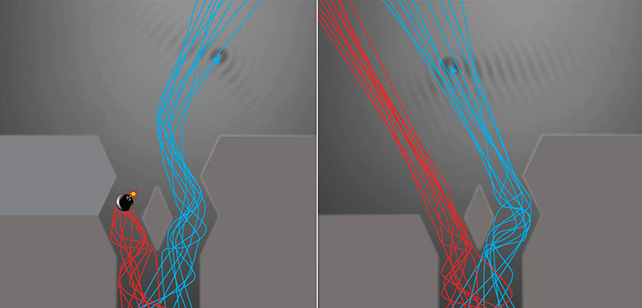Quantum physics is so fundamentally strange that we need the hidden cat in the box thought experiment and the metaphor of a spinning coin to begin to understand its laws.
However, even in the more intuitive classical world of physics, shades of quantum behavior can be represented using relatively simple scenarios.
Researchers experimented with tiny oil droplets flowing down two adjacent channels in a vibrating fluid bath and found that the droplets behaved in a manner consistent with a famous quantum thought experiment.
“It turns out that this hydrodynamic guided wave experiment demonstrates many features of quantum systems that were previously thought to be classically inaccessible,” said John Bush, a fluid dynamicist at MIT. understand.”
Busch and his colleague Valeri Frumkin, a physicist at MIT, modeled the Elitzur-Vaidman bomb tester, a well-known example of interaction-free measurements that could exploit another The gentle caress of an object’s waves to deduce the details of an object’s quantum state without disturbing either of the object’s subtle nature.
This method has been applied to low-intensity imaging techniques, but despite its utility, there is no consensus on the physical meaning of “no interaction.”
In bomb tester experiments, photons split into two states simultaneously (superposition).The two states propagate along one of two channels, and half the time, there is a “bomb” in one of the channels, a metaphor for an object that can destroy the superposition by absorbing photons and destroying its own quantum state in the process.
If a photon emerged from the system, it most likely did not encounter any bombs. The magic of quantum physics is that the state of a split photon when it reassembles into a whole can also tell us whether a bomb is present, even if the photon occupies another channel and does not “detonate” the bomb.
From a classical physics perspective, this makes no sense, but that’s why we have quantum physics. Fundamentally, bombs interfere with the probability of superposition creating photons. This interference can be detected when the wave-like properties of the photons are finally measured.
It is therefore surprising to find the same results in the classical setting in this study.
The droplets displace the photons, and the ripples in the liquid they create act like superposition probability. If these expanding ripples hit a bomb, this will affect the droplet when the two channels merge again, even if the droplet itself occupies the other channel.
Technically, the experiment has more in common with an explanation of quantum experiments known as pilot wave theory, in which interacting ripples carrying tiny surfing particles guide the properties of an object.
Statistically, the classic experiment matches the Elitzur-Vaidman bomb tester. Researchers say it demonstrates a bridge between the fixed solid world of classical physics and the murkier, less certain quantum realm.
This helps us understand more about why quantum behaviors like possibility waves seem to “collapse” into discrete states.
“We have a classical system that provides the same statistics as the quantum bomb test, which is considered one of the wonders of the quantum world,” Bush said.
“In fact, we found that this phenomenon is not so wonderful after all. This is another example of quantum behavior that can be understood in terms of local realism.”
The study was published in Physical Review A.
#Physicists #discover #surprising #quantumlike #behavior #tiny #bouncing #droplets
Image Source : www.sciencealert.com
